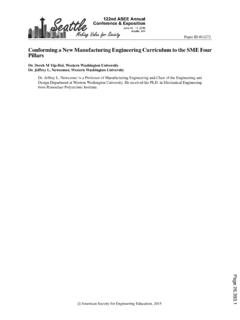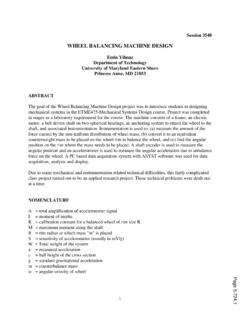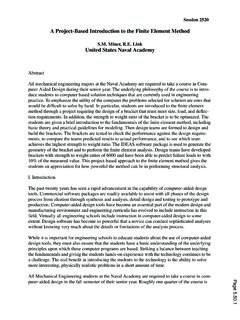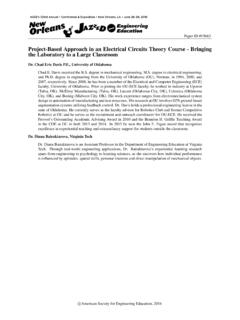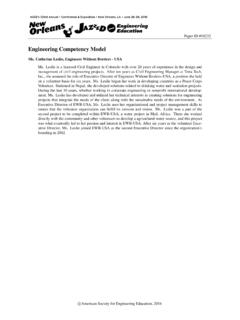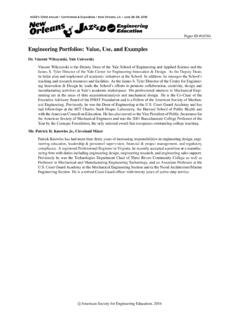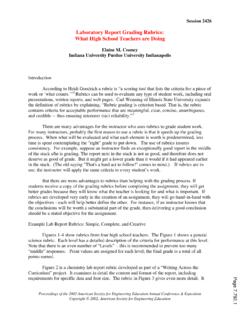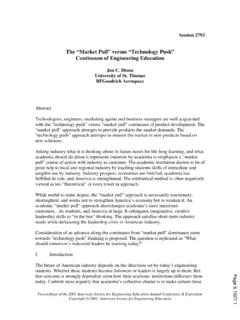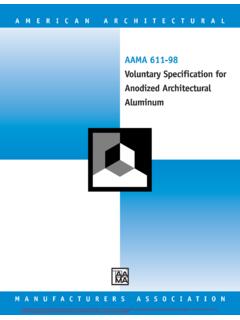Transcription of Results Of A Simple Corrosion Experiment In A Freshman ...
1 Session 3264 Results of a Simple Corrosion Experiment in a Freshman Materials CourseJohn R. WilliamsPurdue University Statewide TechnologyAbstractCorrosion and its prevention is an important aspect of materials studies. This paper presentsresults of Simple experiments developed for use in a time-limited course. Conventionalcorrosion rate experiments are time consuming, but yield useful Corrosion rate data that can beused for design considerations. The lab work described here is oriented toward rapid, visualresults that can be correlated to the effects of material structure, grain size, and techniques are presented describing how to perform these Simple experimentsand listing the equipment needed. Typical Results are presented along with explanations of theanticipated Results . Potential pitfalls are discussed. Student comments are also provided.
2 Thepaper includes photographs of typical experiments also help the student to develop powers of observation and reporting as wellas teach them something about the Corrosion effects of Corrosion are obvious all around us. The etching of metallurgical samples and theway a battery works are examples of electrochemical processes. Visit a junk yard and observethe rusted hulks that were once someone's shiny new car. Non-functional farm machinery oftenlitters the landscape because it costs too much to haul it away to a landfill. Those of us living inthe rust belt wax the exterior of our vehicles, and often pay someone to provide a rust protectivecoating on the underside of them. Approximately 20% of the iron and steel productsmanufactured each year are used to replace objects that have been discarded due to rust 1 is a photograph of a truck ravaged by Corrosion typical of damage brought primarily byroad salt used for winter 1.
3 An older vehicle shows the effects of corrosionThe Purdue University School of Technology requires all AS and BS degree MechanicalEngineering Technology students to take a sequence of materials-related courses. The firstPage covers metals, plastics and ceramics. Several years ago, it occurred to the author thatthere should be some way in the first course, to demonstrate the effects of galvanic Corrosion in asimple way, that would not cost much, nor take a long time to see visible Results . Over thecourse of four years, the author has developed methods of demonstrating in a qualitative way theeffects of Corrosion and to show how it can be prevented. Since our students do not havechemistry until the junior year, the lecture material covers the essentials of galvanic corrosionand the chemistry involved. Quantitative Corrosion testing takes a great deal of time and utilizesnasty corrodents, like boiling sulfuric acid, to measure Corrosion rates.
4 The experimentsdescribed here provide almost immediate visual Results for the InformationOur students have already learned how cold working of a metal produces strengthening and alsoresults in large grains being broken into many smaller grains. They have also learned aboutrecrystallization through heating. In addition, instruction has been given concerning theformation of passive layers in stainless steels and other similar materials. In the Corrosion unit,the galvanic series is introduced and it is shown how materials that are higher in the series willcorrode preferentially to materials that are lower. Essential to the discussion are the fiveconditions that must be present simultaneously before Corrosion can occur2. These conditionsare:1. there must be an anode where a metal is there must be a cathode where some ions are a potential (voltage) must exist between the anode and cathode, usually provided bydissimilar there must be an electrolyte in contact with both anode and there must be a physical electrical connection between the anode and cathode to completethe circuit so that the electrons can our students, it is necessary to emphasize that oxidation is a process whereby a material loseselectrons and reduction is a process whereby a material gains electrons3.
5 Several textbooksillustrate this process using classical electron Electrolytes are usually liquids that conductelectricity, although certain solid oxides can act as electrolytes as well as some vapors5,6. It isimportant that the students understand all of these concepts in order to evaluate the Results fromthe laboratory demonstration. The tie-in between cold work, anodes and cathodes is then made,describing how cold work simply creates large numbers of anodes and cathodes, which areessential for galvanic Corrosion to occur. The anodes are the grain boundaries and the cathodesare the grains7. As the anodes are consumed, the grains and boundaries exchange roles, reversingthe polarity. This interchange continues until the entire material has been consumed. Since theiron oxide crystal is larger and less dense than the steel crystals, the oxide buckles as it is formed,exposing fresh steel to Demonstration SamplesThere is an endless list of materials which could be used to demonstrate galvanic Corrosion andits prevention.
6 It is important to keep the list relatively small to prevent overloading the studentswith observations to make. It is also important to limit the list to materials that are readilyavailable. We are fortunate at our location to have a supply of tensile test specimens fornumerous materials. We selected a number of these for use as Corrosion samples, as well asPage hardware items available at reasonable cost from local sources such as hardware 1 lists some candidate materials that can be used for the Corrosion demonstration. Not allof these items should be used for one demonstration. If class size is large, it is desirable to dividethe class into groups and limit the number of samples to be observed to about six or 1. Candidate Corrosion MaterialsAISI 1010 Hot rolled steel tensile sampleAISI 1010 Hot rolled steel tensile sample, one side groundAISI 1010 Hot rolled steel tensile sample with MIG weld beadAISI 1010 Hot rolled steel tensile sample with magnesium strip attachedAISI 4340 Cold rolled steel tensile sampleCommon steel nails, one bent, one straightBrass tensile sample, CA 360, half-hardAluminum tensile sample, 6061-T6 Copper tensile sampleInconel tensile sampleHastelloy tensile sampleBright zinc plated steel hardware, such as an "S" hookPunched zinc coated steel strip used for shelvingHot-dipped zinc coated roofing nailCadmium plated bolt or screwStainless steel boltSuggested Corrodents and ContainersGlass jars are best to hold the electrolyte selected to permit easy access for students to view thecorrosion activity.
7 Spaghetti sauce jars, with plain sides, work best for visibility and allowphotographs to be made. The jars are carefully washed, labels are removed and all traces of gluecleaned off before use. In response to student comments, labels are provided that clearly explainwhat material and what corrodent is in each can choose from a large number of common liquids to be used as corrodents. Good resultshave been achieved with common household bleach, diluted 100:1 with water. Ordinary tapwater has been used, although distilled or even deionized water would give better control ofresults. Other materials including calcium chloride solution (similar to road salt), ammonia,drain cleaner, dilute hydrochloric or sulfuric acids could be used with selected Corrosion Experimental ProcedureIt is important to clean the samples, removing any oils that might be on the surface.
8 An alcoholwash is a good idea. Each sample material is suspended in the glass jar using nylon fishing line,poly string or polyethylene film. In each case, the string is held by the jar lid. If significantevolution of gas is anticipated, clear film can be placed over the jar opening and the stringsecured with a rubber band. It is suggested that the jar be filled with the corrodent beforeinserting the sample. A good cover is needed to prevent evaporation. For the tensile specimens,Page small hole is drilled in each one, allowing the string to be inserted. Other materials can havethe support tied on or looped are given a data sheet on which to record their observations. They are to observe thesamples about one hour after immersion and every other day after that. If possible, more frequentobservations for the first 24 hours might be useful.
9 The observations are usually ended after oneor two weeks. Students are encouraged to note the progress of Corrosion , if any, and drawsketches. It is best if they do not touch or move the ResultsThe Results obtained from steel samples are discussed below. Results from other materials aresummarized in Table rolled steel rolled material is protected by a black oxide coating that occurs during , since these samples are sheared, the edges have undergone significant cold work. Oneshould see rust forming on the sheared edges during the first hour of immersion. The samplehaving the weld bead on it should show rust forming at the edge of weld first. This is due to coldwork that occurs as the weld cools. The sample edges will not rust as rapidly in this case due torecrystallization that occurred during the welding process.
10 The sample that has the magnesiumstrip attached should rust very little, but the magnesium strip may be consumed. This is ofcourse, an example of cathodic protection, where the magnesium becomes the anode that isconsumed to protect the cathode. (Most hot water heaters have a magnesium rod installed forthis purpose.) Figures 2, 3 and 4 show the progress of Corrosion for some hot-rolled materialsafter 48 hours of a strip with one side having the oxide layer removed is used, one will see immediate rusting ofthat side, but very little on the reverse side. This is the same principle as the magnesium strip,the bare side oxidizes first, protecting the other side. In one case, a student suggested applyingcar wax to the ground side. The corrodent quickly penetrated the wax coating. Other protectiveschemes can be attempted. If the sheared strips are heated to the recrystallization temperatureand slowly cooled, the resulting larger grains in the sheared area should lead to reducedoxidation.


